Suspending belief
Jerkbaits ideal tools for catching bass in late winter, early spring
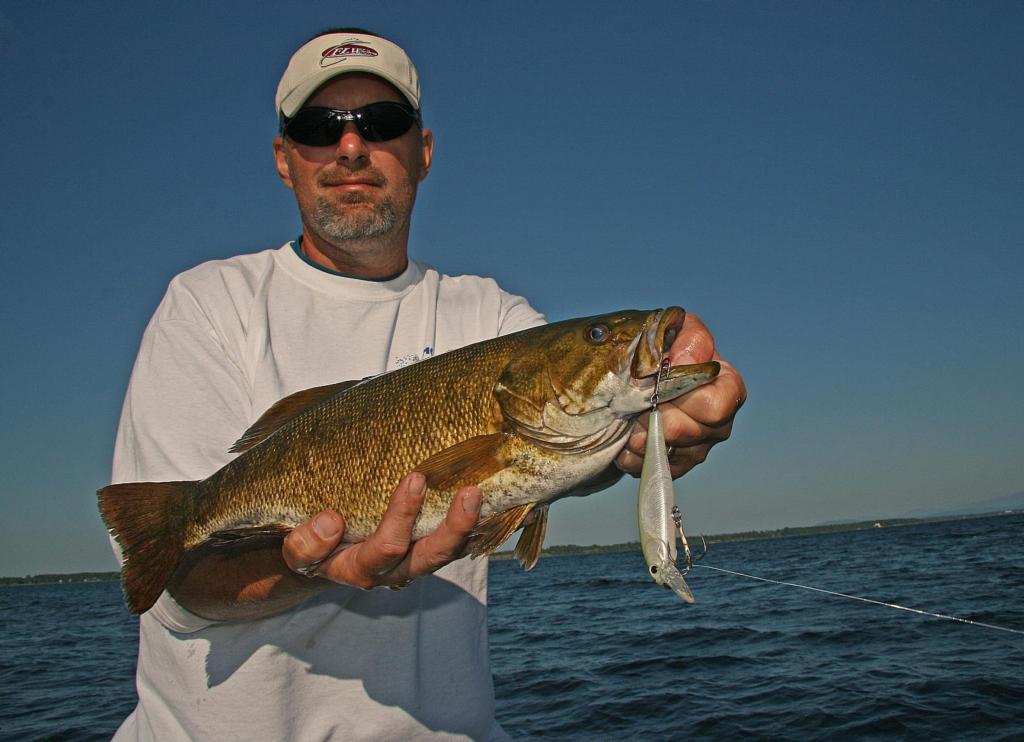
Borrowing a familiar theme of stage and screen, this is art – make that “artificials” – imitating life. Sounds obvious, right? That’s what lures are supposed to do. But as we move toward the time when winter begrudgingly yields its icy grip to spring’s still-distant arrival, jerkbaits can be one of the most effective offerings for bass in cold water.
A devout jerkbait fan, A.C. Campbell of Woodland, Pa., knows the importance of being able to fish at a slow pace in order to maximize success in late winter and early spring. But Campbell is also keenly aware of the necessity of employing baits that closely resemble the appearance of cold-season shad kills. And that’s where jerkbaits come into play. When dead and dying baitfish offer easy pickings, bass become conditioned to the image of suspending, fluttering forage. Mimic this look and you’re very likely to find something willing to stretch your string.
“When the water temperature gets between 30 and 50 degrees, I use jerkbaits 99 percent of the time,” Campbell said. “I use a lot of suspending jerkbaits, and when you get around a school of fish, if you have a jerkbait (hanging) in the water column and shimmering, they can’t stand it. They’ll slam it.”
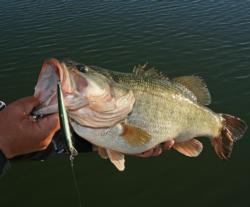 EverStart Series pro Mike “Cowboy” Foree agrees, adding: “This is my No. 1 bait this time of the year when the water temperature gets below 45 degrees and the shad die. When shad die, they head up to the top and then fall slowly. A jerkbait is designed to imitate that.”
EverStart Series pro Mike “Cowboy” Foree agrees, adding: “This is my No. 1 bait this time of the year when the water temperature gets below 45 degrees and the shad die. When shad die, they head up to the top and then fall slowly. A jerkbait is designed to imitate that.”
A stretch of sunny weather can spark the jerkbait bite, as the solar warmth reaches into the chilly depths and encourages prespawners to move up and feed. The fish become more cautious with higher visibility, but a windy day can balance things out by breaking up the surface and lowering that caution level.
As Campbell discovered, jerkbaits even have their place in Florida’s relatively shallow, weedy lakes. When cold-front conditions started creeping into his practice for the Everstart Southeast Division event on Lake Okeechobee in early January, Campbell was catching bass in the Kissimmee River on points, drains and rocks – targeting west-facing structure as it was best for warmth. Viable scenarios are many, but the common thread is the tantalizing appeal of suspending or slow-sinking presentations.
The right retrieve
Given the fish’s general state of cold-season lethargy, minimal action is often the best action this time of year. Savvy anglers often pull their bait down to the target zone and then kill it. The fish see what resembles a suspended baitfish, and instinct does the rest.
“The fish are not in a very aggressive mood this time of year,” said Foree, who hails from Osage Beach, Mo. “Sometimes when the water gets down into the upper 30s, we may let the bait sit for 15 seconds at time.”
Arkansas angler Bub Taylor says he’ll use such subtle rod movement that his jerkbait barely makes any forward progress. He’ll often work his bait so slowly that a full retrieve takes up to three minutes. Patterns will carry over, but consistent jerkbait productivity demands an open mind and a creative approach. Simply put, the fish will likely want a different look each day.
“Patience is (essential),” Campbell said. “The colder the water, the longer the pause you have to give it. Be versatile until you find something that works.”
Knowing your opponent proves essential here. Campbell said he occasionally fares well with a slow, straight retrieve – something that only works on smallmouth bass.
“A largemouth would never hit that,” he said. “They want it sitting right in front of them. But that steady retrieve can be a real knockout bite for smallies. So there is a difference.”
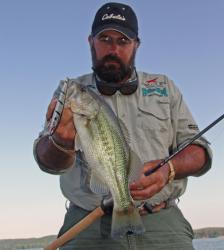 Test your lures by hanging them next to the boat and watching how they sit in the water. Adjusting hook and split-ring size, along with adding weight dots or strips, will alter the bait’s buoyancy up or down. Suspending presentations probably account for the majority of jerkbait bites, but some days will find frisky fish willing to chase down a falling plug.
Test your lures by hanging them next to the boat and watching how they sit in the water. Adjusting hook and split-ring size, along with adding weight dots or strips, will alter the bait’s buoyancy up or down. Suspending presentations probably account for the majority of jerkbait bites, but some days will find frisky fish willing to chase down a falling plug.
Case in point: While fishing Arkansas’ Norfork Lake, Foree was unaware that his Smithwick Rogue was broken. Furthermore, he didn’t realize that the bait had sunk to the bottom when he backlashed his reel. Once he cleared the line and came tight, the Rogue drew a vicious strike.
“A fish just waylayed it, and I said, `That’s pretty cool,'” Foree recalls. “I threw it out again and let it sink to the bottom. I popped it and caught another fish. That’s the problem with most anglers – they try to make the fish do what they want them to do instead of figuring out what the fish want.”
Send in the jerks
Campbell said his prime jerkbait scenarios include:
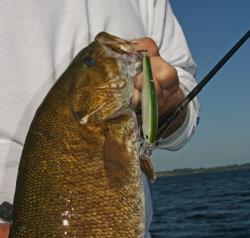 Bluff walls and bait shows: On waters like Pickwick Lake or Lake of the Ozarks, he’ll run along the bluffs and watch his electronics for shad schools. West-facing walls are best, as they’ll absorb the afternoon sun and warm surrounding water. With an arsenal including Lucky Craft Pointer 100s, Smithwick Rattling Rogues and Rapala Husky Jerks, he’ll try different sizes and actions to achieve just the right impersonation.
Bluff walls and bait shows: On waters like Pickwick Lake or Lake of the Ozarks, he’ll run along the bluffs and watch his electronics for shad schools. West-facing walls are best, as they’ll absorb the afternoon sun and warm surrounding water. With an arsenal including Lucky Craft Pointer 100s, Smithwick Rattling Rogues and Rapala Husky Jerks, he’ll try different sizes and actions to achieve just the right impersonation.
Outside river bends: When fishing manmade reservoirs such as Alabama’s Lake Eufaula, Campbell knows the morning hours will find the fish suspending in deeper water – often over rocks or the tips of lay-downs – so he starts by probing the depths with Spoonbill Rattling Rogues. Once the sun warms the shallows, he’ll work his way onto the flats, where Pointer 100s or 85s can do a lot of damage.
“If the sun comes out in the afternoon, sometimes those fish will creep their way up onto the flats in 8 to 10 feet,” Campbell said. “I’ve caught fish in 6 inches of water on sunny days. There are times when you almost have to hit the bank with your bait. You pull it out ever so slightly, and they’ll hit it.”
White weather: “If you’re out fishing and there’s a heck of a snow storm, don’t run to the bank – those fish will hit a jerkbait,” Campbell said. “I can’t explain it, but I’ve fished tournaments where we had 10 inches of snow and I’m shoveling snow from the front deck, but I’ve caught 30-pound bags on jerkbaits.”
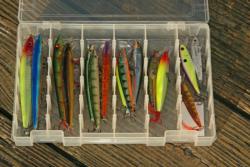 Favoring the Megabass Vision 110 in blues, whites and greens, Foree said one of his favorite jerkbait situations occurs on his home waters at Lake of the Ozarks. When the winter drawdown moves baitfish to the deeper brush piles, he’ll send his suspending bait right into the danger zone and let the bass stare at it until either appetite or attitude drives them to bite.
Favoring the Megabass Vision 110 in blues, whites and greens, Foree said one of his favorite jerkbait situations occurs on his home waters at Lake of the Ozarks. When the winter drawdown moves baitfish to the deeper brush piles, he’ll send his suspending bait right into the danger zone and let the bass stare at it until either appetite or attitude drives them to bite.
And don’t put those jerkbaits away once the big spawners overtake the shallows. The annoyance of a baitfish imitator hovering right in the nursery is way more than mama bass can tolerate, so swim one into the kill zone and let it wear out its welcome.
Tackle and tactics
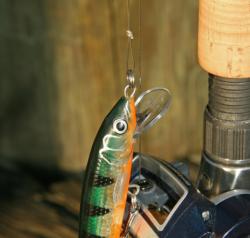 Maximize your jerkbait action by tying your line to a snap and clipping that to the split ring. Much less restricting than a straight knot connection, the clip affords your bait optimal mobility for the side-to-side fluttering action that coaxes strikes. A loop knot affixed through the line tie accomplishes the same.
Maximize your jerkbait action by tying your line to a snap and clipping that to the split ring. Much less restricting than a straight knot connection, the clip affords your bait optimal mobility for the side-to-side fluttering action that coaxes strikes. A loop knot affixed through the line tie accomplishes the same.
When finicky fish need a little nudging, feathered baits like Rapala’s X-Rap models can tease an otherwise absent response. Some days the fish may be cool with bare hooks, but keep a box of Rapala’s “dressed” trebles – standard X-Rap Tail or SureSet trebles – handy for any necessary enhancements.
Campbell prefers a 6-foot-6-inch medium-action baitcasting outfit for most of his jerkbait duties, but he’ll go with spinning gear when throwing the smaller plugs. In either case, a 5.1:1 reel ensures the requisite slow retrieve.
On the fight, Foree said it’s important to resist the temptation to yank your bass into the boat ASAP. Of course, he doesn’t dally capriciously, but Foree knows the ills of rushing a jerkbait fish.
“I use as little drag as possible,” he said. “The hooks are so sharp on these lures they pull out easily. I just let the fish run around a little and wear them down, and then I ease them back to the net.”